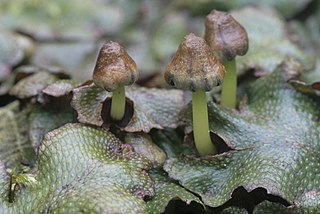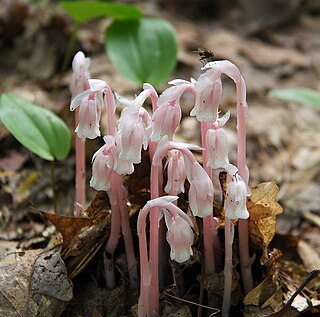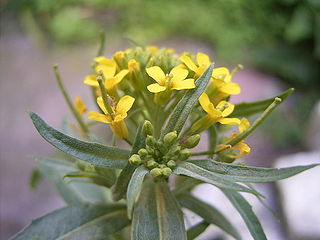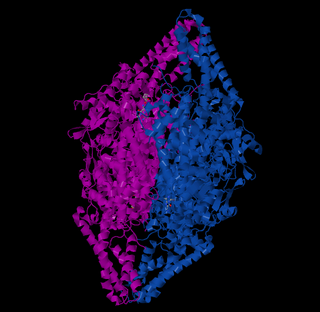
The Marchantiophyta are a division of non-vascular land plants commonly referred to as hepatics or liverworts. Like mosses and hornworts, they have a gametophyte-dominant life cycle, in which cells of the plant carry only a single set of genetic information.

Conocephalum is a genus of complex thalloid liverworts in the order Marchantiales and is the only extant genus in the family Conocephalaceae. Some species of Conocephalum are assigned to the Conocephalum conicum complex, which includes several cryptic species. Conocephalum species are large liverworts with distinct patterns on the upper thallus, giving the appearance of snakeskin. The species Conocephalum conicum is named for its cone-shaped reproductive structures, called archegoniophores. Common names include snakeskin liverwort, great scented liverwort and cat-tongue liverwort.

Sabinene is a natural bicyclic monoterpene with the molecular formula C10H16. It is isolated from the essential oils of a variety of plants including Marjoram, holm oak (Quercus ilex) and Norway spruce (Picea abies). It has a strained ring system with a cyclopentane ring fused to a cyclopropane ring.
Monoicy is a sexual system in haploid plants where both sperm and eggs are produced on the same gametophyte, in contrast with dioicy, where each gametophyte produces only sperm or eggs but never both. Both monoicous and dioicous gametophytes produce gametes in gametangia by mitosis rather than meiosis, so that sperm and eggs are genetically identical with their parent gametophyte.
Denitrobacterium is a genus of Actinomycetota with a single species, in the family Coriobacteriaceae. Originally isolated from the bovine rumen, Denitrobacterium are non-motile and non-spore forming. The only described species in this genus is Denitrobacterium detoxificans. The specific niche of this bacterium in the bovine rumen is theorized to be the detoxification/metabolism of nitrotoxins and miserotoxin.

Myco-heterotrophy is a symbiotic relationship between certain kinds of plants and fungi, in which the plant gets all or part of its food from parasitism upon fungi rather than from photosynthesis. A myco-heterotroph is the parasitic plant partner in this relationship. Myco-heterotrophy is considered a kind of cheating relationship and myco-heterotrophs are sometimes informally referred to as "mycorrhizal cheaters". This relationship is sometimes referred to as mycotrophy, though this term is also used for plants that engage in mutualistic mycorrhizal relationships.

Erysimum cheiranthoides, the treacle-mustard,wormseed wallflower, or wormseed mustard is a species of Erysimum native to most of central and northern Europe and northern and central Asia. Like other Erysimum species, E. cheiranthoides accumulates two major classes of defensive chemicals: glucosinolates and cardiac glycosides.

The enzyme phenylalanine ammonia lyase (EC 4.3.1.24) catalyzes the conversion of L-phenylalanine to ammonia and trans-cinnamic acid.:

Ergosterol peroxide (5α,8α-epidioxy-22E-ergosta-6,22-dien-3β-ol) is a steroid derivative. It has been isolated from a variety of fungi, yeast, lichens and sponges, and has been reported to exhibit immunosuppressive, anti-inflammatory, antiviral, trypanocidal and antitumor activities in vitro.
Cullen plicatum, synonym Psoralea plicata, is a herb species in the genus Psoralea. It is native from northern Africa to north-west India and to South Africa.

Dihydrostilbenoids (bibenzyls) are natural phenols formed from the dihydrostilbene (bibenzyl) backbone.

Lunularic acid is a dihydrostilbenoid found in the liverwort Lunularia cruciata and in the roots of Hydrangea macrophylla.
Lunularic acid decarboxylase is an enzyme that converts lunularic acid into lunularin.

Lunularin is a dihydrostilbenoid found in common celery. It has also been found in the roots of Hydrangea macrophylla.

Hypolaetin is a flavone. It is the aglycone of hypolaetin 8-glucuronide, a compound found in the liverwort Marchantia berteroana. Hypolaetin 8-glucoside can be found in Sideritis leucantha.
Root mucilage is made of plant-specific polysaccharides or long chains of sugar molecules. This polysaccharide secretion of root exudate forms a gelatinous substance that sticks to the caps of roots. Root mucilage is known to play a role in forming relationships with soil-dwelling life forms. Just how this root mucilage is secreted is debated, but there is growing evidence that mucilage derives from ruptured cells. As roots penetrate through the soil, many of the cells surrounding the caps of roots are continually shed and replaced. These ruptured or lysed cells release their component parts, which include the polysaccharides that form root mucilage. These polysaccharides come from the Golgi apparatus and plant cell wall, which are rich in plant-specific polysaccharides. Unlike animal cells, plant cells have a cell wall that acts as a barrier surrounding the cell providing strength, which supports plants just like a skeleton.

Ploiarium is a genus of three species of woody plants in the family Bonnetiaceae. It is native to tropical forests and peat swamp forests in Southeast Asia including southern Indochina, Malay Peninsula, Sumatra, and Borneo. Species are generally slow growing with irregular flowering and fruiting cycles. Colonization of plants by arbuscular mycorrhizal fungi is known to improve growth and biomass.

Conocephalum salebrosum, commonly known as snakewort, is a species of liverwort, a non-vascular land plant, with a broad, holarctic distribution. It is also known as snakeskin liverwort, cat-tongue liverwort, mushroom-headed liverwort, and great scented liverwort.
Wilfred "Wilf" Borden Schofield was a Canadian botanist, specializing in mosses and liverworts. He was considered by many "the foremost bryologist in Canada".
Conocephalum supradecompositum is a species of thalloid liverwort in the genus Conocephalum, of the order Marchantiales and the family Conocephalaceae. C. supradecompositum has a distribution that is mainly restricted to China and Japan. C. supradecompositum has very distinct chemical composition from the species Conocephalumconicum.













